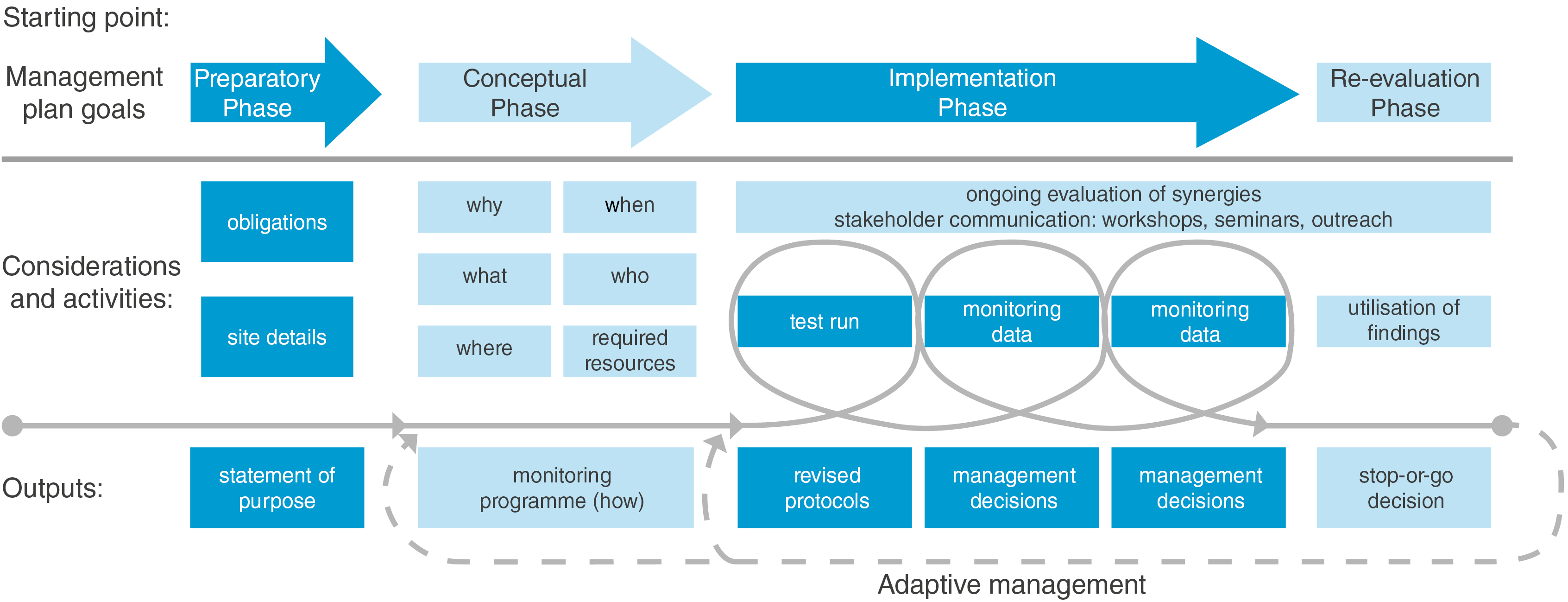

Site management activities are determined by management plan goals, protected assets, actual or potential threats, the demands of different stakeholders, and from changing uses of the PA or OECM and surrounding areas. Site-specific conditions will impact the scope of the biodiversity monitoring programmes that make up the biodiversity monitoring system. In many cases, requirements on indicators and protocols already exist and should first be considered, such as the objectives of a country’s National Biodiversity Strategic Action Plan that is required by the Convention on Biological Diversity. Legal obligations from other national or international policies may also exist. Additional site-specific background information will reveal any knowledge gaps that can be improved in later phases. The main objective of PAs is to conserve biodiversity, whilst for OECMs the most important biodiversity values may need to be identified in advance of developing a biodiversity monitoring system. This is because biodiversity conservation often occurs as a side product of management of OECMs. The output of the preparatory phase is a clear programme-specific statement of purpose that identifies priority questions for monitoring. Documenting the approaches used to address a particular monitoring question will help other sites in the network implement effective protocols.
With clearly defined biodiversity goals from the statement of purpose, the next step is to document the questions and answers that guide the specific biodiversity monitoring programme. This step is the conceptual phase. The conceptual phase is assisted by the use of the monitoring concept worksheet, a tool that helps to focus the many considerations of biodiversity monitoring programmes through a series of six basic questions: ‘why’ establish the monitoring programme, ‘what’ will be monitored, ‘where’ and ‘when’ will monitoring occur, ‘who’ are the stakeholders involved, and what ‘required resources’ are needed. Questions can be considered in any order and can be revisited at any time. It is recommended to review all questions at least two times. After the questions have been considered, the framework of ‘how’ monitoring will be conducted and the synergies with other monitoring programmes will complete the monitoring concept worksheet. A key output of the conceptual phase will be to document supporting decisions on which tools and methods will be used in the next phase of the monitoring programme, implementation. Working through the six questions will identify how monitoring will be conducted and potential synergies with the larger management programme or national network. We provide a printable poster-sized version of the monitoring concept worksheet to help managers and staff make the necessary considerations.
The actual monitoring occurs during the implementation phase of the monitoring programme. This phase involves specific steps for performing field work and data collection. The necessary materials should be acquired, and a preliminary manual describing the details of the field work should be produced. Field workers should be trained according to the finalised field manual. After training, at least one test run should occur at an easily accessible site. Any changes should be recorded in the manual, and training and test run cycles should be repeated until the work flow functions as planned. Data collection can then begin at field sites through monitoring cycles that are repeated at appropriate intervals, depending on the indicators. Statistical analysis of the collected data should occur periodically during the implementation phase. Presentation of the results should be given transparently and in appropriate formats to different stakeholder groups. Findings should support adaptive management decisions, provide the basis for Protected Area Management Effectiveness (PAME) reporting, and can be valuable for outreach.
The fourth phase is the re-evaluation phase. The timing of this phase is typically defined through funding cycles or reporting requirements to comply with biodiversity treaties. Findings are given to decision-makers to identify strengths and weaknesses of the biodiversity monitoring programme. Effective components can be transferred to other site monitoring programmes, or within national and regional biodiversity monitoring networks. Sharing findings can maximise synergies with other programmes because successful elements may serve as templates for further use in other PAs and OECMs. The outcome of the re-evaluation phase is the decision to continue, adjust, or terminate the monitoring activities.
